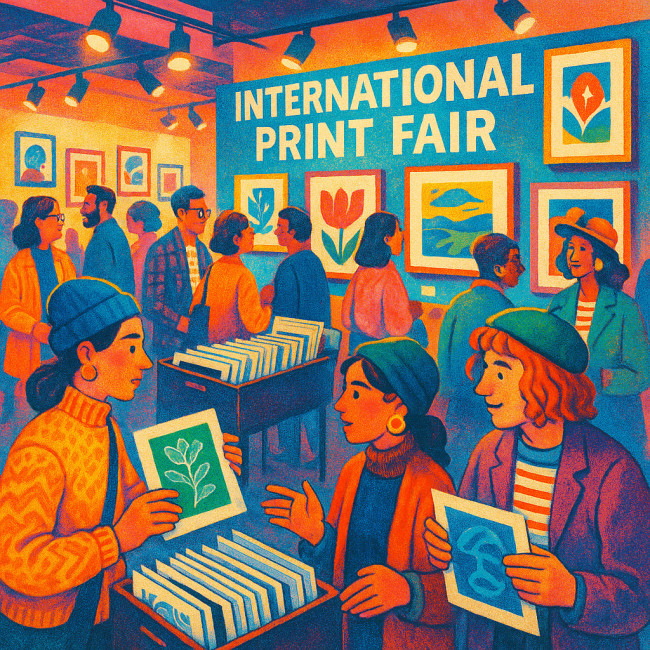Printmaker fairs calendar: limited-edition swaps and sales strategies
Want to boost your print sales, swap expertise with peers and lock-in gallery leads? Our printmaker fairs calendar gives you the key dates, proven booth tactics and limited-edition strategies you need to turn every fair into a profit engine.
Why a printmaker fairs calendar is your fastest route to steady sales
Print fairs concentrate your ideal buyers—collectors, curators and design scouts—into one buzzing venue. Planning six to nine months ahead lets you:
- Secure early-bird booth rates and prime corner spots.
- Map production so fresh editions launch with each fair.
- Schedule studio partnerships to share press time and trim costs.
- Align social and email teasers with fair marketing peaks.
2025 printmaker fairs calendar at a glance

From London's gilded exhibition halls to Melbourne's converted warehouses, print fairs wrap an entire market cycle into a single weekend. The atmosphere is equal parts gallery, pop-up shop and reunion tour: spotlights bounce off fresh ink, curators angle for portfolio previews, and collectors scan edition numbers like stock tickers. Reading the calendar as a production blueprint lets you reverse-engineer every deadline—drying times, framing, shipping—so nothing derails the launch buzz.
| Month | Fair | City | Edition Size Trend | Booth Booking Deadline |
|---|---|---|---|---|
| January | London Original Print Fair | London, UK | 25–50 copies | 15 Oct 2024 |
| March | PrintAustin Expo | Austin, USA | 15–30 copies | 1 Dec 2024 |
| May | Multiple Impressions | Melbourne, AUS | 10–20 copies | 15 Feb 2025 |
| September | Festival de la Gravure | Montreal, CAN | 30–60 copies | 1 Jun 2025 |
| November | INK Miami | Miami, USA | 20–35 copies | 15 Jul 2025 |
Bookmark the full worldwide list on the Artfolio events hub and sync reminders with your studio calendar.
Pre-fair production: limited-edition tactics that convert
Use staggered scarcity
Plan three scarcity tiers per design—standard, hand-finished and artist proof. This approach echoes the upsell method detailed in our editioned print add-ons guide. Collectors love choosing their commitment level, and you keep a lower-priced door opener on the table.
Numbering and certificates
Avoid vague “open edition” tags. Clear numbering boosts trust and resale value. Follow the rules from the complete numbering handbook: pencil number on the print, match the certificate, and log every sale in a cloud sheet.
Prep swap stock
Artist-to-artist swaps build long-term collaboration and diversify your portfolio visuals. Print five to ten extra copies of your headline piece expressly for swaps—you'll walk away with new work to sell online without additional press time.
Booth layout that sells in 90 seconds
- Hero wall: Show one large framed flagship print to stop foot traffic.
- Edition ladder: Place mid-sized variants below, descending by price.
- Flip bin: Collect tactile browsers—include poly-bagged test pulls and proofs.
- Process corner: Display plates or screens alongside QR codes linking to your behind-the-press reels.
Tip: keep tables at 75 cm height so buyers can flick through without hunching—spend comfort correlates with dwell time.
Pricing matrix: set fair-only incentives
Use a clear A-frame sign listing:
- Fair-exclusive price (10 % below online store).
- Bundle offer: any three small prints for one mid-sized price.
- Loyalty perk: pre-order next edition at current rate today.
This transparent structure beats haggling and keeps margins predictable.
Sales psychology: scripts that close deals
The limited-edition reassurance
“Only 25 of these exist. We're down to the last six—would you like to reserve a low number?”
Scarcity plus low inventory nudges action.
The process story
“Each tone comes from a separate lino block. It took 14 passes under the press to reach this depth.”
Buyers pay for craft, not just paper. A concise process description validates price.
Add-on cross-sell
“If you like this size, the hand-finished variant includes gold leaf highlights and ships framed.”
Highlight tangible upgrades rather than abstract “premium” labels.
After-fair follow-up: turn one-off buyers into patrons
Within 48 hours, email each buyer:
- High-resolution image of their purchase for social sharing.
- Survey link asking which future themes interest them.
- Private preview code for your next drop.
Consistent post-show contact lifts repeat purchase rate by up to 30 % in niche art markets.
Collaborative opportunities you shouldn't miss
Curators often scout print fairs for crossover projects—book jackets, interior décor, product packaging. Being ready with licensing slides opens doors to deals covered in our royalty models guide.
FAQ
- How many editions should I bring to a mid-sized fair?
- Three to five core designs with 15–30 copies each balance variety and transport costs.
- Do small proofs devalue the main edition?
- No. Label them “study prints” and cap them at 5–10 copies to maintain hierarchy.
- Should I frame prints on site?
- Frame only one hero piece. Offer unframed copies in archival sleeves to avoid breakage and extra shipping fees.
- What payment methods are essential?
- Card tap, Apple Pay and PayPal QR cover 90 % of buyer preferences; keep limited cash for backup.
- How do I track certificates efficiently?
- Pre-number, pre-sign and log in a cloud sheet accessible from your phone; update inventory immediately after each sale.
Quick quiz: ready for your next print fair?
Take action today
Download the dates above, block studio time and start teasing your next edition on social. A well-planned printmaker fairs calendar turns sporadic sales into a predictable revenue curve—one fair at a time.











